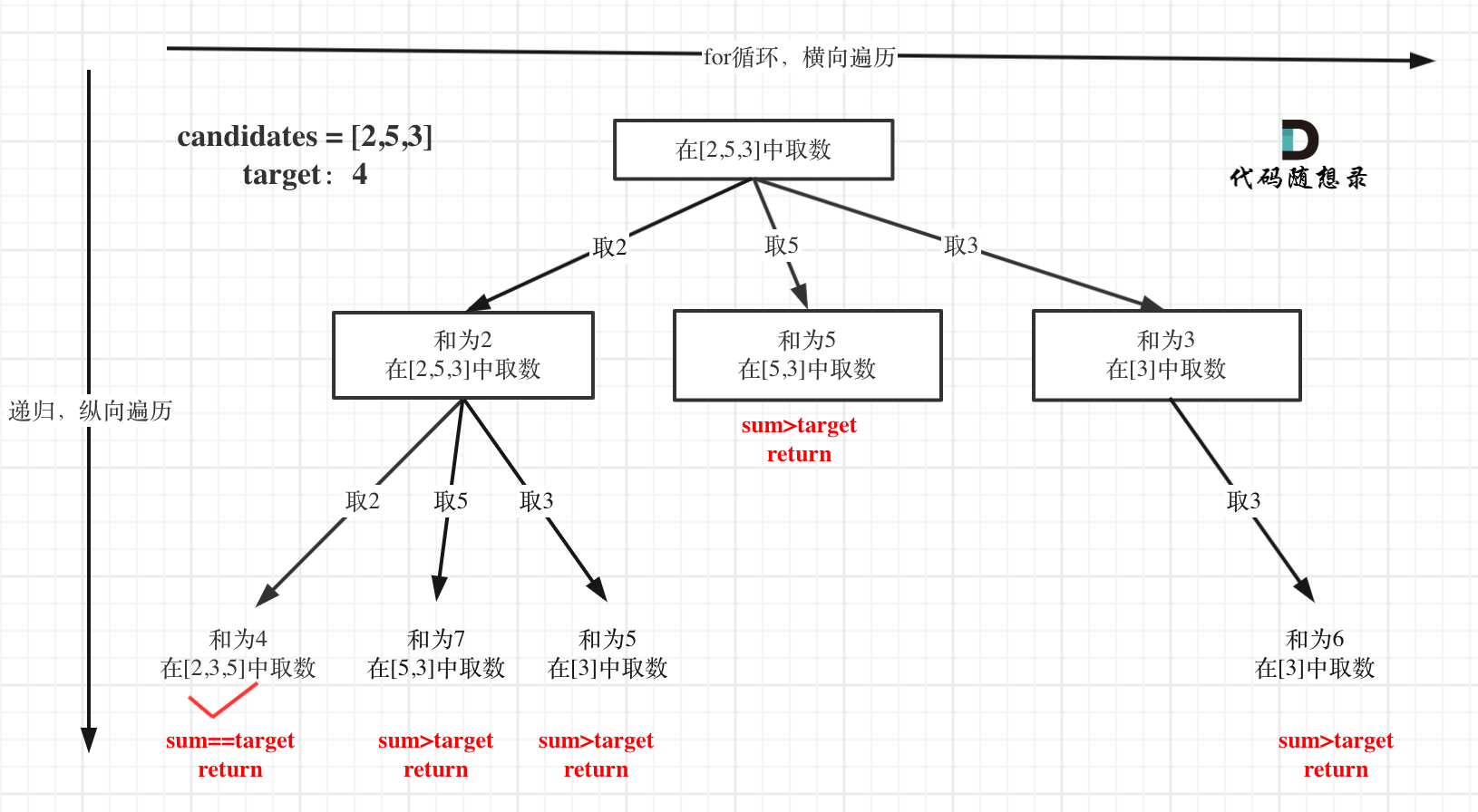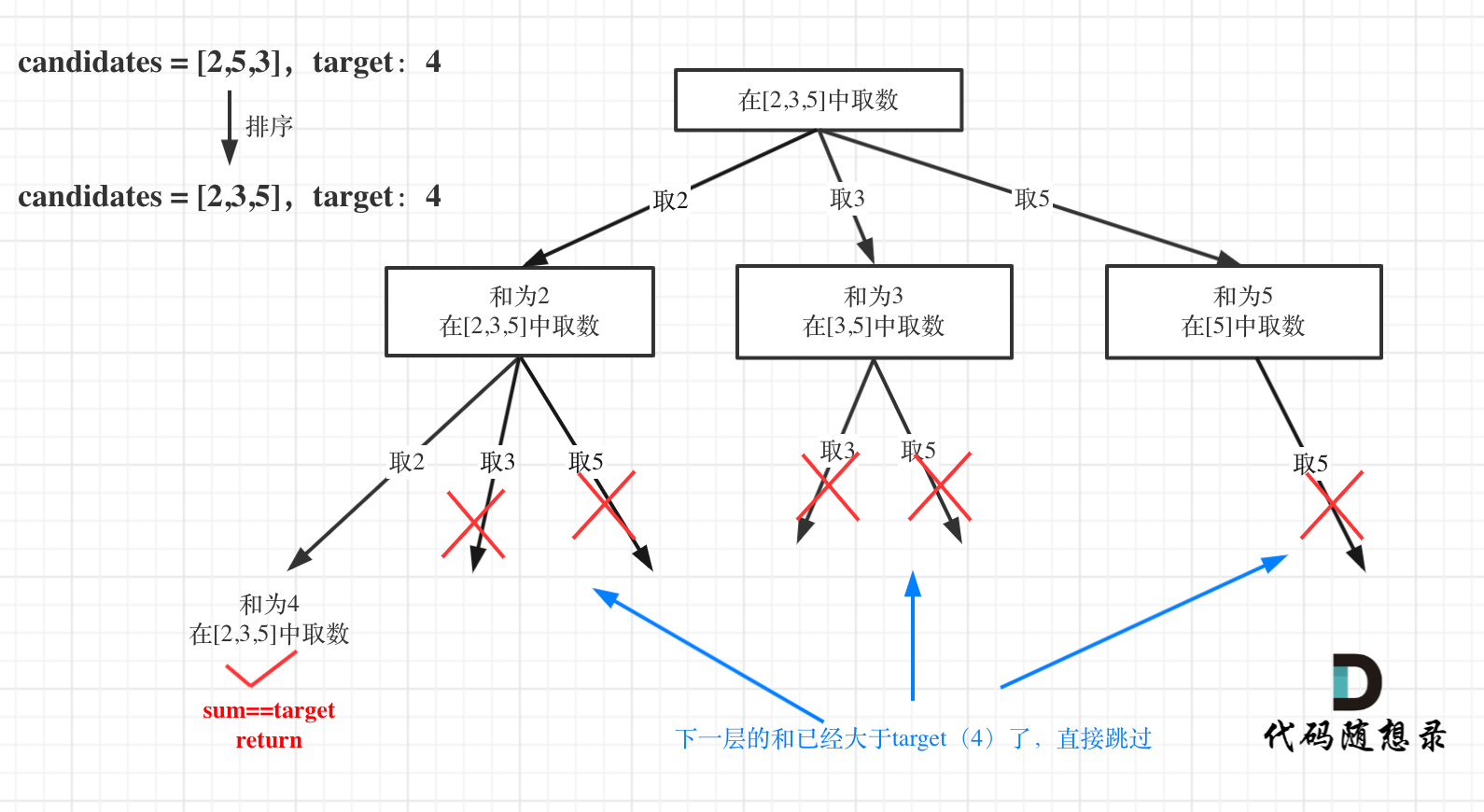参与本项目,贡献其他语言版本的代码,拥抱开源,让更多学习算法的小伙伴们收益!
给定一个无重复元素的数组 candidates 和一个目标数 target ,找出 candidates 中所有可以使数字和为 target 的组合。
candidates 中的数字可以无限制重复被选取。
说明:
- 所有数字(包括 target)都是正整数。
- 解集不能包含重复的组合。
示例 1:
- 输入:candidates = [2,3,6,7], target = 7,
- 所求解集为: [ [7], [2,2,3] ]
示例 2:
- 输入:candidates = [2,3,5], target = 8,
- 所求解集为: [ [2,2,2,2], [2,3,3], [3,5] ]
《代码随想录》算法视频公开课:Leetcode:39. 组合总和讲解,相信结合视频再看本篇题解,更有助于大家对本题的理解。
题目中的无限制重复被选取,吓得我赶紧想想 出现0 可咋办,然后看到下面提示:1 <= candidates[i] <= 200,我就放心了。
本题和77.组合,216.组合总和III的区别是:本题没有数量要求,可以无限重复,但是有总和的限制,所以间接的也是有个数的限制。
本题搜索的过程抽象成树形结构如下:

而在77.组合和216.组合总和III 中都可以知道要递归K层,因为要取k个元素的组合。
- 递归函数参数
这里依然是定义两个全局变量,二维数组result存放结果集,数组path存放符合条件的结果。(这两个变量可以作为函数参数传入)
首先是题目中给出的参数,集合candidates, 和目标值target。
此外我还定义了int型的sum变量来统计单一结果path里的总和,其实这个sum也可以不用,用target做相应的减法就可以了,最后如何target==0就说明找到符合的结果了,但为了代码逻辑清晰,我依然用了sum。
本题还需要startIndex来控制for循环的起始位置,对于组合问题,什么时候需要startIndex呢?
我举过例子,如果是一个集合来求组合的话,就需要startIndex,例如:77.组合,216.组合总和III。
如果是多个集合取组合,各个集合之间相互不影响,那么就不用startIndex,例如:17.电话号码的字母组合
注意以上我只是说求组合的情况,如果是排列问题,又是另一套分析的套路,后面我再讲解排列的时候就重点介绍。
代码如下:
vector<vector<int>> result;
vector<int> path;
void backtracking(vector<int>& candidates, int target, int sum, int startIndex)- 递归终止条件
在如下树形结构中:
从叶子节点可以清晰看到,终止只有两种情况,sum大于target和sum等于target。
sum等于target的时候,需要收集结果,代码如下:
if (sum > target) {
return;
}
if (sum == target) {
result.push_back(path);
return;
}- 单层搜索的逻辑
单层for循环依然是从startIndex开始,搜索candidates集合。
注意本题和77.组合、216.组合总和III的一个区别是:本题元素为可重复选取的。
如何重复选取呢,看代码,注释部分:
for (int i = startIndex; i < candidates.size(); i++) {
sum += candidates[i];
path.push_back(candidates[i]);
backtracking(candidates, target, sum, i); // 关键点:不用i+1了,表示可以重复读取当前的数
sum -= candidates[i]; // 回溯
path.pop_back(); // 回溯
}按照关于回溯算法,你该了解这些!中给出的模板,不难写出如下C++完整代码:
// 版本一
class Solution {
private:
vector<vector<int>> result;
vector<int> path;
void backtracking(vector<int>& candidates, int target, int sum, int startIndex) {
if (sum > target) {
return;
}
if (sum == target) {
result.push_back(path);
return;
}
for (int i = startIndex; i < candidates.size(); i++) {
sum += candidates[i];
path.push_back(candidates[i]);
backtracking(candidates, target, sum, i); // 不用i+1了,表示可以重复读取当前的数
sum -= candidates[i];
path.pop_back();
}
}
public:
vector<vector<int>> combinationSum(vector<int>& candidates, int target) {
result.clear();
path.clear();
backtracking(candidates, target, 0, 0);
return result;
}
};在这个树形结构中:
以及上面的版本一的代码大家可以看到,对于sum已经大于target的情况,其实是依然进入了下一层递归,只是下一层递归结束判断的时候,会判断sum > target的话就返回。
其实如果已经知道下一层的sum会大于target,就没有必要进入下一层递归了。
那么可以在for循环的搜索范围上做做文章了。
对总集合排序之后,如果下一层的sum(就是本层的 sum + candidates[i])已经大于target,就可以结束本轮for循环的遍历。
如图:
for循环剪枝代码如下:
for (int i = startIndex; i < candidates.size() && sum + candidates[i] <= target; i++)
整体代码如下:(注意注释的部分)
class Solution {
private:
vector<vector<int>> result;
vector<int> path;
void backtracking(vector<int>& candidates, int target, int sum, int startIndex) {
if (sum == target) {
result.push_back(path);
return;
}
// 如果 sum + candidates[i] > target 就终止遍历
for (int i = startIndex; i < candidates.size() && sum + candidates[i] <= target; i++) {
sum += candidates[i];
path.push_back(candidates[i]);
backtracking(candidates, target, sum, i);
sum -= candidates[i];
path.pop_back();
}
}
public:
vector<vector<int>> combinationSum(vector<int>& candidates, int target) {
result.clear();
path.clear();
sort(candidates.begin(), candidates.end()); // 需要排序
backtracking(candidates, target, 0, 0);
return result;
}
};本题和我们之前讲过的77.组合、216.组合总和III有两点不同:
- 组合没有数量要求
- 元素可无限重复选取
针对这两个问题,我都做了详细的分析。
并且给出了对于组合问题,什么时候用startIndex,什么时候不用,并用17.电话号码的字母组合做了对比。
最后还给出了本题的剪枝优化,这个优化如果是初学者的话并不容易想到。
在求和问题中,排序之后加剪枝是常见的套路!
可以看出我写的文章都会大量引用之前的文章,就是要不断作对比,分析其差异,然后给出代码解决的方法,这样才能彻底理解题目的本质与难点。
// 剪枝优化
class Solution {
public List<List<Integer>> combinationSum(int[] candidates, int target) {
List<List<Integer>> res = new ArrayList<>();
Arrays.sort(candidates); // 先进行排序
backtracking(res, new ArrayList<>(), candidates, target, 0, 0);
return res;
}
public void backtracking(List<List<Integer>> res, List<Integer> path, int[] candidates, int target, int sum, int idx) {
// 找到了数字和为 target 的组合
if (sum == target) {
res.add(new ArrayList<>(path));
return;
}
for (int i = idx; i < candidates.length; i++) {
// 如果 sum + candidates[i] > target 就终止遍历
if (sum + candidates[i] > target) break;
path.add(candidates[i]);
backtracking(res, path, candidates, target, sum + candidates[i], i);
path.remove(path.size() - 1); // 回溯,移除路径 path 最后一个元素
}
}
}回溯
class Solution:
def __init__(self):
self.path = []
self.paths = []
def combinationSum(self, candidates: List[int], target: int) -> List[List[int]]:
'''
因为本题没有组合数量限制,所以只要元素总和大于target就算结束
'''
self.path.clear()
self.paths.clear()
self.backtracking(candidates, target, 0, 0)
return self.paths
def backtracking(self, candidates: List[int], target: int, sum_: int, start_index: int) -> None:
# Base Case
if sum_ == target:
self.paths.append(self.path[:]) # 因为是shallow copy,所以不能直接传入self.path
return
if sum_ > target:
return
# 单层递归逻辑
for i in range(start_index, len(candidates)):
sum_ += candidates[i]
self.path.append(candidates[i])
self.backtracking(candidates, target, sum_, i) # 因为无限制重复选取,所以不是i+1
sum_ -= candidates[i] # 回溯
self.path.pop() # 回溯剪枝回溯
class Solution:
def __init__(self):
self.path = []
self.paths = []
def combinationSum(self, candidates: List[int], target: int) -> List[List[int]]:
'''
因为本题没有组合数量限制,所以只要元素总和大于target就算结束
'''
self.path.clear()
self.paths.clear()
# 为了剪枝需要提前进行排序
candidates.sort()
self.backtracking(candidates, target, 0, 0)
return self.paths
def backtracking(self, candidates: List[int], target: int, sum_: int, start_index: int) -> None:
# Base Case
if sum_ == target:
self.paths.append(self.path[:]) # 因为是shallow copy,所以不能直接传入self.path
return
# 单层递归逻辑
# 如果本层 sum + condidates[i] > target,就提前结束遍历,剪枝
for i in range(start_index, len(candidates)):
if sum_ + candidates[i] > target:
return
sum_ += candidates[i]
self.path.append(candidates[i])
self.backtracking(candidates, target, sum_, i) # 因为无限制重复选取,所以不是i-1
sum_ -= candidates[i] # 回溯
self.path.pop() # 回溯主要在于递归中传递下一个数字
var (
res [][]int
path []int
)
func combinationSum(candidates []int, target int) [][]int {
res, path = make([][]int, 0), make([]int, 0, len(candidates))
sort.Ints(candidates) // 排序,为剪枝做准备
dfs(candidates, 0, target)
return res
}
func dfs(candidates []int, start int, target int) {
if target == 0 { // target 不断减小,如果为0说明达到了目标值
tmp := make([]int, len(path))
copy(tmp, path)
res = append(res, tmp)
return
}
for i := start; i < len(candidates); i++ {
if candidates[i] > target { // 剪枝,提前返回
break
}
path = append(path, candidates[i])
dfs(candidates, i, target - candidates[i])
path = path[:len(path) - 1]
}
}var combinationSum = function(candidates, target) {
const res = [], path = [];
candidates.sort((a,b)=>a-b); // 排序
backtracking(0, 0);
return res;
function backtracking(j, sum) {
if (sum === target) {
res.push(Array.from(path));
return;
}
for(let i = j; i < candidates.length; i++ ) {
const n = candidates[i];
if(n > target - sum) break;
path.push(n);
sum += n;
backtracking(i, sum);
path.pop();
sum -= n;
}
}
};function combinationSum(candidates: number[], target: number): number[][] {
const resArr: number[][] = [];
function backTracking(
candidates: number[], target: number,
startIndex: number, route: number[], curSum: number
): void {
if (curSum > target) return;
if (curSum === target) {
resArr.push(route.slice());
return
}
for (let i = startIndex, length = candidates.length; i < length; i++) {
let tempVal: number = candidates[i];
route.push(tempVal);
backTracking(candidates, target, i, route, curSum + tempVal);
route.pop();
}
}
backTracking(candidates, target, 0, [], 0);
return resArr;
};impl Solution {
pub fn backtracking(result: &mut Vec<Vec<i32>>, path: &mut Vec<i32>, candidates: &Vec<i32>, target: i32, mut sum: i32, start_index: usize) {
if sum == target {
result.push(path.to_vec());
return;
}
for i in start_index..candidates.len() {
if sum + candidates[i] <= target {
sum += candidates[i];
path.push(candidates[i]);
Self::backtracking(result, path, candidates, target, sum, i);
sum -= candidates[i];
path.pop();
}
}
}
pub fn combination_sum(candidates: Vec<i32>, target: i32) -> Vec<Vec<i32>> {
let mut result: Vec<Vec<i32>> = Vec::new();
let mut path: Vec<i32> = Vec::new();
Self::backtracking(&mut result, &mut path, &candidates, target, 0, 0);
result
}
}int* path;
int pathTop;
int** ans;
int ansTop;
//记录每一个和等于target的path数组长度
int* length;
void backTracking(int target, int index, int* candidates, int candidatesSize, int sum) {
//若sum>=target就应该终止遍历
if(sum >= target) {
//若sum等于target,将当前的组合放入ans数组中
if(sum == target) {
int* tempPath = (int*)malloc(sizeof(int) * pathTop);
int j;
for(j = 0; j < pathTop; j++) {
tempPath[j] = path[j];
}
ans[ansTop] = tempPath;
length[ansTop++] = pathTop;
}
return ;
}
int i;
for(i = index; i < candidatesSize; i++) {
//将当前数字大小加入sum
sum+=candidates[i];
path[pathTop++] = candidates[i];
backTracking(target, i, candidates, candidatesSize, sum);
sum-=candidates[i];
pathTop--;
}
}
int** combinationSum(int* candidates, int candidatesSize, int target, int* returnSize, int** returnColumnSizes){
//初始化变量
path = (int*)malloc(sizeof(int) * 50);
ans = (int**)malloc(sizeof(int*) * 200);
length = (int*)malloc(sizeof(int) * 200);
ansTop = pathTop = 0;
backTracking(target, 0, candidates, candidatesSize, 0);
//设置返回的数组大小
*returnSize = ansTop;
*returnColumnSizes = (int*)malloc(sizeof(int) * ansTop);
int i;
for(i = 0; i < ansTop; i++) {
(*returnColumnSizes)[i] = length[i];
}
return ans;
}func combinationSum(_ candidates: [Int], _ target: Int) -> [[Int]] {
var result = [[Int]]()
var path = [Int]()
func backtracking(sum: Int, startIndex: Int) {
// 终止条件
if sum == target {
result.append(path)
return
}
let end = candidates.count
guard startIndex < end else { return }
for i in startIndex ..< end {
let sum = sum + candidates[i] // 使用局部变量隐藏回溯
if sum > target { continue } // 剪枝
path.append(candidates[i]) // 处理
backtracking(sum: sum, startIndex: i) // i不用+1以重复访问
path.removeLast() // 回溯
}
}
backtracking(sum: 0, startIndex: 0)
return result
}object Solution {
import scala.collection.mutable
def combinationSum(candidates: Array[Int], target: Int): List[List[Int]] = {
var result = mutable.ListBuffer[List[Int]]()
var path = mutable.ListBuffer[Int]()
def backtracking(sum: Int, index: Int): Unit = {
if (sum == target) {
result.append(path.toList) // 如果正好等于target,就添加到结果集
return
}
// 应该是从当前索引开始的,而不是从0
// 剪枝优化:添加循环守卫,当sum + c(i) <= target的时候才循环,才可以进入下一次递归
for (i <- index until candidates.size if sum + candidates(i) <= target) {
path.append(candidates(i))
backtracking(sum + candidates(i), i)
path = path.take(path.size - 1)
}
}
backtracking(0, 0)
result.toList
}
}

